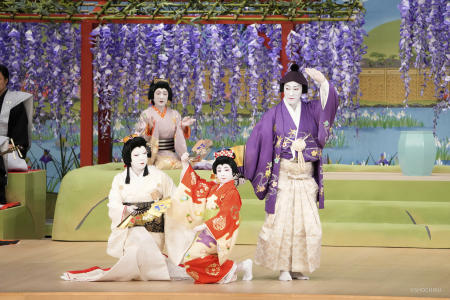
- ARAB NEWS
- 14 Jul 2025

TOKYO: Theater students from the University of Hawaii at Manoa are travelling to Japan in June to stage a rare English-language kabuki production at a classic playhouse in Gifu Prefecture, as a homecoming for a kabuki tradition taken to the Pacific islands by Japanese immigrants in the 19th century.
The show, part of the UHM’s kabuki project to produce “The Maiden Benten and the Bandits of the White Waves,” better known as “Benten Kozo,” comes after performances at the on-campus Kennedy Theatre in Honolulu in April to mark the centennial anniversary of the first English-language kabuki performance ever given in Hawaii in 1924.
“Benten Kozo” is a popular kabuki play depicting the twists and turns of five thieves following their own code of honor.
The project is led by UHM Prof. Julie Iezzi, a 61-year-old Asian theater specialist, in collaboration with Ichikawa Monnosuke VIII, 64, the eighth generation of a kabuki family lineage stretching back to 1713, during Japan’s Edo era.
The production includes 29 students–17 actors, three stage managers, two designers and seven musicians–who have gone through a year of intensive training in their respective disciplines, with Monnosuke flying from Japan to coach kabuki voice and movement, and to audition students for the show.
Monnosuke was first invited to the UHM in 2019 to teach a summer workshop with Iezzi.
“I knew from before that some of our seniors were teaching kabuki at the UHM, and when I saw videos of past productions, I was impressed that they were very authentic and thought that I should share my own experience in kabuki (with the students),” Monnosuke said. “Seeing the students study a theater form non-native to them so enthusiastically, I wanted to help them do it properly.”
“His participation is absolutely central,” Iezzi emphasizes, as the veteran actor literally embodies the art of kabuki.
“It’s important that students learn directly from the source of the art, and with the permission of the artist, especially in this age of cultural appropriation,” adds the professor, who holds a master’s degree from Tokyo University of the Arts.
The UHM’s kabuki production is similar to “jikabuki” regional plays performed by local amateur actors in Japan. The first documented kabuki performance in Hawaii, which was in Japanese, dates back to 1893, about a quarter of a century after Japanese people started migrating there in 1868 to work on sugar plantations.
The first-generation immigrants flocked to theaters in their communities to remember their homeland.
In 1924, the first English-language kabuki play was performed on the campus of the University of Hawaii by second-generation Japanese-American students. Titled “The Faithful,” it was an adaptation of “Kanadehon Chushingura,” a popular drama based on the famous revenge of 47 masterless samurai in the 18th century.
English kabuki was produced each year until the outbreak of World War II. It resumed at the university in 1951 and has since evolved into an academic program with collaborations with the community and professional actors from Japan.
The UHM has long developed a unique method of kabuki training. Students are told to learn the roles first in Japanese, and then perform in English. According to Iezzi, most students do not speak Japanese.
“Not knowing Japanese is an advantage in a way, as it forces them to listen intently, and to really hear and learn to replicate the quality and placement of the sound,” she asserts.
“Benten Kozo” is a famous piece written by Kawatake Mokuami, whose lines are known for a rhythmical seven-and-five syllable meter.
“Mokuami’s lines are very musical, so it’s like putting the English lines on the melody,” Monnosuke points out.
“I was surprised at the UHMs method at first, but it seems to work because Prof. Iezzi has crafted the translation to fit so well.”
The students also learned a lot from him on how to move according to roles they play.
“It is difficult just to walk on stage. For example, a samurai should walk in a dignified manner, by lowering the center of gravity, while a townsman should have a higher center of gravity with a different stride length,” the kabuki star notes.
From an educational point of view, the program is not just for helping students to become familiar with the Japanese performing art that dates back over four centuries.
“It provides them with a new way of learning, new way of acting, new way of seeing the world … through a different lens, a Japanese lens,” says Iezzi, who was charmed by kabuki as a young college student in the 1980s.
Performances for the homecoming event are set to take place first at Gifu Clear Stream Culture Plaza in the city of Gifu on June 1 and then at the main venue of Aioi-za in another Gifu prefectural city of Mizunami the following day. The two-day event has been arranged by Oguri Sachie, 76, director of the Mino Kabuki Preservation Society, a local kabuki troupe of amateur actors.
Oguri, who runs the traditional Aioi-za playhouse, has been working closely with Iezzi for the kabuki production, furnishing a set of kimono costumes for Benten and his gang and helping to prepare wigs for the show, among other tasks.
“Hawaii’s kabuki and Mino Kabuki have both been nurtured by locals,” Oguri emphasizes.
The UHM professor expects that the Aioi-za show, in particular, will be thrilling.
“It is an amazing opportunity for our students and members of our community to experience what an Edo-era kabuki playhouse was like,” Iezzi says. “It’s also a very special and life-changing chance for true cultural exchange between Hawaii and Japan.”
“The homecoming performance will prove that kabuki has survived overseas,” Oguri suggests. “I hope that people (involved in jikabuki) will realize that if kabuki is being well preserved in Hawaii, they should try to maintain and promote their own kabuki.”
JIJI Press